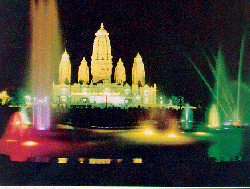Current weather conditions in kanpur
History & Location
Nestled on the banks of the eternal Ganga, Kanpur stands as one of North
India’s major industrial centres with its own historical,
religious and commercial importance.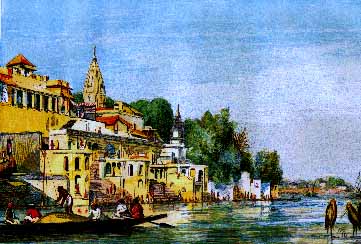 Believed to be founded by
king Hindu Singh of the erstwhile state of Sachendi, Kanpur was
originally known as `Kanhpur’. Historically, Jajmau on the
eastern outskirts of present day Kanpur is regarded as one of the
most archaic tounships of Kanpur district.
Believed to be founded by
king Hindu Singh of the erstwhile state of Sachendi, Kanpur was
originally known as `Kanhpur’. Historically, Jajmau on the
eastern outskirts of present day Kanpur is regarded as one of the
most archaic tounships of Kanpur district.
Upto the 1st half of the 18th
century Kanpur continued to survive as an insignificant village.
Its fate, however, took a new turn soon after. In May 1765,
Shuja-ud-daula, the Nawab Wazir of Awadh, was defeated by the
British near Jajmau. It was probably at this time that strategic
importance of the site of Kanpur was realised by the British.
European businessmen had by this time gradually started
establishing themselves in Kanpur. In order to ensure protection
to their lives and property the `Awadh local forces’ were
shifted here in 1778. Kanpur passed into British hands under the
treaty of 1801 with Nawab Saadat Ali Khan of Awadh. This forms a
turning point in the history of Kanpur. Soon Kanpur became one of
the most important military station of British India. It was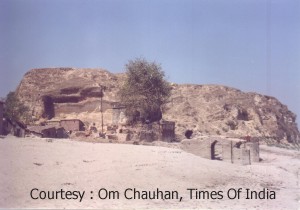 declared a district on 24th March 1803.
declared a district on 24th March 1803.
Kanpur in 1857
Kanpur was soon to become the epicentre of
the outbreak of 1857, as some of the leading luminaries of the
War of Independence hailed from her, namely – Nana Sahib,
Tantiya Tope, Azimoolah Khan and Brigadier Jwala Prasad. The
three strategic events of the 1857 war at Kanpur were the fight
at `wheeler’s entrenchment’, the `massacre at Sati
Chaura Ghat’ and the `Bibighar massacre’. Nana Sahib
had declared independence on th 7th of June 1857 at
Kanpur. The British under Commander Hugh Wheeler retreated into a
shallow earch entrenchment in the cantonment area, later known in
history as `wheeler’s entrenchment’. The English
garrison surrendered in the last week of June 1857 on terms of
safe passage to Allahabad. But when on the morning of 27th
June, the soldiers along with the women and children were about
to embark into the boats at Sati Chaura Ghat, fighting broke out
and most of the men were killed. The survivors, women and
children were rescued who were imprisoned into the Savada Kothi
and later shifted to Bibighar in the `cantonment
magistrates’ compound. But when it became clear the
relieving forces under General Havelock were nearing the city and
defeat was inevitable, the captives-all women and children, were
massacred and their dismembered bodies buried in the well of the
compound on 15th July 1857. The Bibighar was
dismantled by the British and reoccupation of Kanpur and a
`memorial railing and a cross’ raised at the site of the
well. The well is now bricked over. Only remains of a circular
ridge survive, which can be still seen at the Nana Rao Park. The
Kanpur Memorial Church – `The all soul cathedral’ was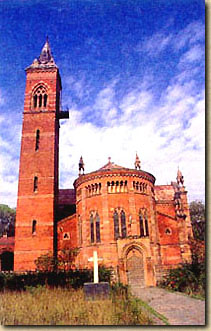 raised in honour of the fallen at the north-east corner of
Wheeler’s entrenchment in 1862 by the British. The marble
gothic screen with famous `mournful scarf’ was transferred
to the churchyard of All Souls after independence in 1947, and in
its place a bust of Tantiyu Tope installed as Nana Rao
Park’.
raised in honour of the fallen at the north-east corner of
Wheeler’s entrenchment in 1862 by the British. The marble
gothic screen with famous `mournful scarf’ was transferred
to the churchyard of All Souls after independence in 1947, and in
its place a bust of Tantiyu Tope installed as Nana Rao
Park’.
After 1857, the development of Kanpur was even more phenomenal. Government Harnes and Saddlery Factory was started for supplying leather material for army in 1860, followed by Cooper Allen & Co. in 1880. The first cotton textile mill, the Elgin Mills were started in 1862 and Muir Mills in 1882.
Today besides being the most industrialised region of the state, Kanpur is also an important educational centre, with institutions like Harcourt Butler Technological Institute, Agricultural College, Indian Institute of Technology, GSVM Medical College, National Sugar Institute and Government Textile Institute being located here. Apart from playing a stellar role in the development of the country as a whole, Kanpur has also been instrumental in making an unforgettable contribution to the Indian freedam struggle. A favourite centre of activities of stalwarts like Nanarao Peshwa, Tantiya Tope, Sardar Bhagat Singh and Chander Shekhar Azar among others, Kanpur is also the birth place of Shyamlal Gupta `Parshad’, composer of the famous patriotic ditty `Vijayee Vishwa Tiranga Pyara’. The propagation and popularisation of Hindi also owes much to this city, with great Hindu literatures like Acharya Mahavir Parasad Dwivedi, Ganesh Shanker Vidyarthi, Pratap Narain Mishra, Acharya Gaya Prasad Shukla `Sanehi’ and Balkrishna Sharma `Navin’ having hailed from here.
About the CITY
- Area : 1040 Sq. km.
- Population : 2418447 (1991 census)
- Altitude : 126 meters above sea level.
- Season : November-February
- Clothing (Summer) : Cottons; (Winter) : Woollens
- Language : Hindi & English
- Local Transport : Buses, Taxis, Tempos, Auto-Rickshaws.
- STD Code : 0512
Important Addresses
- District Magistrate, Kanpur Central. Phone: 311677.
- District Magistrate, Kanpur, Dehat. Phone: 311267.
- SSP. Phone: 311407.
- Fire. Phone: 44444
- Ambulance. Phone: 62500.
Fairs & Festivals
Deepwali, Deshara, Holi, Raksha-Bandhan, Janma-Asthami, Ram Navami, Shiv-Ratri, Kartik Poornima, Magh Poornima and Makar Sankranti Mela. The city is full of lights in Deepawali ,colorful in Holi festivals
Accessibility
Air
Chakeri Airport, Kanpur, has become operational since January 1996 and is serviced by U.P. Air, Archana Airways and private airlines. Apart from this the nearest airport is Amausi, Lucknow, 65 km.
Rail
Connections to all the major stations of the country by express, super-fast and passenger trains. Some of the important trains that pass through Kanpur Central are;
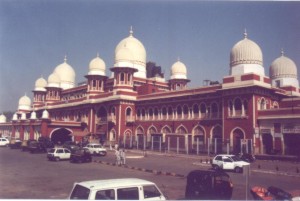
- 2003/2004 ShatabdiExpress (New Delhi/Lucknow)
- 2301/2302 Raajdhaani Express (New Dlehi/Howarah)
- 2381/2382 A/c Express(Amritsar/Calcutta)
- 2303/2304 A/c Express(Amritsar/Calcutta)
- 8475/8476 Neeelanchal Express (New Delh/Puri)
- 3007/3008 Udyan Abha Toofan Express(New Delhi/Calcutta)
- 2521/2522 North East Express (New Delhi/Guwahati)
- 3007/3008 Magadh Vikramshila Express(New Delhi/Patna)
- 2554/2554 Vaishali Express (New Delhi/Barauni)
- 2419/2420 Gomti Express (New Delhi/Lucknow)
- 4163/4164 Sangam Express(Meerut/Allahabad)
- 2133/2134 Pushpak Express
- Prayagraj Express (Delhi/Allahabad)
Road
Kanpur is connected by road with all the major cities of the country. It is situated on National Highway No. 2 on the Delhi-Agra-Allahabad-Calcutta route and on National Highway No. 25 on the Lucknow-Jhansi-Shivpuri route. Distances from some destinations in the region:
- Lucknow – 79 km.
- Allahabad – 193 km.
- Varanasi – 329 km.
- Khajuraho – 398 km.
- Agra – 269 km.
- Jhansi – 222 km.
Places of Interests
Jajmau
The mound of Jajmau, on the eastern end of the city occupies a high place among ancient sities of the region. Excavations of the mound were undertaken during 1957-58 which unearthed antiquities ranging from 600 BC to 1600 AD.
Jajmau,known as Siddhapuri in ancient times, is supposed to have been the kingdom of Yayati, the Pauranic king and the high mound overhanging the Ganga is known as the site of his fort.
Today, Jajmau houses the Siddhnath and Siddha Devi temples and the mousoleium of Makhdum Shah Ala-ul-Haq, the famous Sufi saint, built by Firoz Shah Tughlaq in 1358. A mosque built by Kulich Khan in 1679 also stands here.
Shri Radhakrishna Temple (J.K. Temple)
Beautifully constructed, J.K. temple is a
boon to the devotees. Built by J.K. Trust this architectural
delight is a unique blend of ancient architecture with the.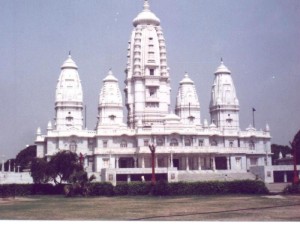 modern. The even-level roofs o the mandaps have been provided
with adequate ventilation for sufficient light and air. Among the
five shrines that the temple has the central one s consecrated to
Shri Radhakrishna and the other are adorned with idols of Shri
Laxminarayan, Shri. Ardhanarishwar, Shri Narmadeshwar and Shri
Hanuman.
modern. The even-level roofs o the mandaps have been provided
with adequate ventilation for sufficient light and air. Among the
five shrines that the temple has the central one s consecrated to
Shri Radhakrishna and the other are adorned with idols of Shri
Laxminarayan, Shri. Ardhanarishwar, Shri Narmadeshwar and Shri
Hanuman.
Jain Glass Temple
It is situated in Maheshwari Mohal behind the Kamla Tower. It is a beautiful temple highly decorated with glass and enamel works.
Allen Forest Zoo
The Kanpur Zoo was opend in 1971 and ranks among one of the best zoos in the country. It is an ideal place for outdoor life and picnics amongst picturesque surroundings. Phone: 543678.
Kamla Retreat
Lies to the west of the Agricultural College in immediate neighbourhood of the Allen Forest. It is under the possession of Singhania family and is a beauty spot of the city. There is a swimming tank with an equipment for producing artificial waves and suitable arrangement for lighting. Besides parks and a canal with facilities for boating, a zoo is also maintained.
Kamla Retreat also houses a museum which has a good collection of historical and archaeological artifacts. Visitors are allowed only with prior permission from:; Deputy General Manager (Administration), Kamla Tower, Kamalanagar, Kanpur, UP. Phone: 311478 & 311479.
Phool Bagh
It is a beautiful park in the heart of the city on the Mall Road. In the centre of the park is a building known as Ganesh Shanker Vidyarthi Memorial. After the first World War there was an Orthopaedic Rehabilitation Hospital in this building. It is now known as Ganesh Udyan.
Nana Rao Park
To the west of Phool Bagh is located the Nana Rao Park. It is the site of the `Bibighar’ of 1857. The Park was renamed as Nana Rao Park after independence.
The Kanpur Memorial Church (All Soul’s Cathedral)
The Kanpur Memorial Church was built in 1875, in honour of the British who lost their lives in the war of 1857. The Church was designed by Walter Granville, architect of the east Bengal Railway. The complete Church in Lombardic gothic style is handsomely executed in bright red brick, with polychrome dressings. The interior contains monuments to the mutiny, including several memorial tablets.
In the separate enclosure to the east of the church is the Memorial Garden, approached through two gateways. Here the handsome carved gothic screen, designed by Henry Yule, stands. Its centre is occupied by the beautiful carved figure of an angle by Baron Carlo Marochetti, with crossed arms, holding palons, symbol of peace. Originally the statue and the screen stood in the Municipal Gardens in the centre of the city, over the site of the Bibighar well. The memorials were relocated here after independence in 1948. The Military Cemetery on the edge of the cantonment contains a number of interesting graves from the late 19th century. Within the city the king Edward VII memorial hall is noteworthy and Christ Church building, built in 1840.
The city which once was termed as manchester of India for its matured cotton industry. The city which hosted (and still hosts) the world famous 'Lal Imli' woolen factory, industries such as LML, Pan Parag, ICI Limited (now known as Duncuns Fertilisers), one of the largest leather industries in the world and myriad cotton mills. The city which boosts one of the lagrest number of defence establishments; To name a few Hindustan Aeronautical Limited (HAL), DMSRDE, Small Arms Factory(SAF), Field Gun Factory and Parachutte factoryProfessional Institutes
Harcourt Butler Technological Institute
The Harcourt Butler Technological Institute was established in 1920 at Kanpur and is engaged in imparting technical training and industrial research. Phone: 294851, 294852, 294853, 294854 & 294855.
Indian Institute of Technology
One of the five IIT’s, set up in 1959 at Kanpur, it provides education in the fields of engineering, technology, science and humanities. Phones: 250151 & 257878.
Chandra Shekhar Azar University of Agriculture & Technology
Established in 1957 to provide education of agriculture, animal husbandry and veterinary science for the benefit of rural people.
Degree Colleges
- PPN Degree College - Naveen Market
- Christ Church Degree College -MG Road
- DAV Degree College - Civil Lines
- DBS Degree College - Govind Nagar
- AND Girls Degree College - Harsh Nagar
- SEN Girls Degree College - Canal Road
Inter Colleges
- PPN Inter College - Naveen Market
- Christ Church Inter College
- RK Mission High School - Gumati
- Chacha Nehru Inter College - Govind Nagar
- BNSD Inter College - Chunni Ganj
Computer Education Centers
- Aptech Computer Education - Naadri Baazar,Swaroop Nagar/Govind Nagar
- NIIT Computer Center - Arya Nagar
- Tata Unisys Education - Parvati Bangla
- UPTECH- Lakhanpur/The Mall
Among other sites worth visiting at Kanpur are the Hanuman temple-Panki, Anandeshwar temple, Jageshwar temple, Dwarikadhish temple, Prayagnarayan temple, Kailash temple, Buddhadevi temple, Kherepati temple, Varahidevi temple, Bhairav temple and Tulsi Upvan (Moti Jheel).
Other Places of Interest
Other Places of Interest are; Tapeshwaridevi Temple, Vankhahdeshwar Temple, Anandeshwar Temple, Moti Jheel Tulsi Upvan-Children Park, Kamla Retreat, Zoological Garden, Nanarao Park-Ganesh Udyan, Prayag Narain Temple. Nanarao Ghat, Panki Hanuman Temple and Shyam Hari Singhania Art Gallary.
Accommodation
- The Lankmark Hotel, 10, The Mall. Phone: 317601, 317602, 317603, 317604 & 317605. Fax: 0512-315291..
- Meghdoot Hotel, The Mall. Phone: 311999. Fax: 0512-310209. Talex: 0325-282 A/B MAGT IN, Cable: Meghotel.
- Sarvodaya Plaza, 3-A,Sarvodaya Nagar. Phone: 217126, 217127 & 217128.
- Meera Inn, Opp. Reserve Bank of India, The Mall. Phones: 319972, 319973, 319974, 319975, 319976, 319978 & 319979.
- Geet Hotel, 18/174-175, Opp. Phool Bhagh, The Mall. Phones; 311042, 311043, 311044, 311045, 311046 & 311024.
- Hotel Bliss, near Gomti No. 5, Gurudwar, 111-A/5, G.T. Road. Phone: 291707, 291731 & 291738.
- Hotel Gaurav, 18/54, The Mall. Phones: 368616 & 369599.
- Hotel Ganges, 51/50, Naya Ganj. Phones: 352853 & 352965.
- Hotel Deep Mayur, 11/274, Sutar Ganj. Phone: 210645.
- Hotel Swagat, 80 Feet Road. Phones: 541923 & 541900.
- Hotel Holiday Inn, 118/16 3-B, Bomber Road, Gumti No. 5, Kanpur. Phone: 219852.
- Anand Guest House, 122/729, Shastri Nagar. Phone: 220496.
- Hotel Aryawat, 51/104, Collector Ganj. Phone: 363132.
- Hotel Ashoka, 24/16, Birhana Road, Kanpur. Phone: 312742.
- Hotel Basera, 70/39, Sutar Khana. Phone: 355398.
- Hotel Bliss, Near Gumti No. 5, Gurudwara, 111 A/5, G.T. Road. Phone: 291703.
- Hotel Deep, 124-C/243, Govind Nagar, Kanpur. Phones: 218136 & 298789.
- Hotel Gem, 40/69 B, Hospital Road, Parade. Phone: 361421. Fax: 318514.
- Hotel Kesar Palace, 110/189, R.K. Nagar, G.T. Road, Kanpur. Phones: 540467 & 546218.
- Hotel Mahadev Regency, 14/124, Parade, The Mall. Phone: 319943.
- Hotel Meera Inn, 37/19, Opp. RBI, The Mall. Phones: 319978, 319979, 319980, 319981 & 319982.
- Hotel Natraj, 71/150, Sutarkhana. Phone: 364231.
- Hotel Raj Mahal, 112/1B, Arya Nagar. Phone: 292134.
- Hotel Swagat, 80, F.T. Road, Brahma Nagar. Phones: 541923 & 541900.
There are also a number of other hotels, guest houses, lodges and dharamshalas in the city.
UP Tourism Accommodations
- Rahi Motel, Tatya Ganj – 12 km.
- Rahi Motel, Fatehpur Roshnai, Rania – 24 km.
- Priyadarshini Motel, Nawabganj, Distt. Unnao. Phones: 05154, 5150, 5160.
Restaurants
The city of Kanpur abounds in restaurants and eateries that cater to vegetarian and non-vegetarian palates. Some restaurants also serve Chinese and continental cuisine.
- Angithi Restaurant, 26/45, The Mall. Phone: 365294.
- Buddhesen, 26/45, Birhana Road. Phone:365294.
- Chung Fa Restaurant, 94-B, Canal Road. Phones: 316131 & 360336.
- Kwality Restaurant, 16/97, The Mall. Phone: 312680.
- Haritma Village Restaurant, 9/3,Macrobert Ganj. Phone: 544338.
- Little Chet Restaurant, 15/198, Civil Lines. Phone: 311725 & 31375.
- Pandit’s Upvan Restaurant. Phone:??????????.
- Crazy Food, Nadri Bazar - Swaroop Nagar
- Foody-Goody Deep, Govind Nagar
- Makhan Singh Biryani, Arya Nagar
- Delhi Darbaar,Mariyam Pur
- Ghosh Sweets, 80 feet Road
- Krishna/Agra/JAI Sweets, Gumati#5
Shopping Malls
Kanpur is famous for leather goods. The main shopping centres in the city are; The Mall, Birhana Road, Gumti No. 5, Parade, Naveen Market, Meston road and P.P.N. Market. The city centre also offers the shopper a delightful array of State Emporia, viz. UPICA, UP Handloom Emporium, The Mall; Phulkari, Punjab Emporium and Manjusha, Bengal Emporium, The Mall.
Banks/Post-Offices/Telegraphs
- State Bank of India, LIC Building. Phone: 312218.
- Punjab National Bank, The Mall. Phones: 311577, 314159, 362117 & 317986.
- Union Bank of India, 24/53, Birhana Road. Phone: 313109.
- Canara Bank, 16/95, The Mall.
- Reserve Bank of India, The Mall. Phones: 311443 & 311191.
- Standard Charted Bank, M.G. Road. Phone: 318089.
- ANZ Grindlays Bank, Bara Chauraha. Phones: 311462 & 311204.
- Allahabad Bank, Bara Chauraha. Phone: 318052.
Post Offices
- Post Office, R.K. Nagar, Phone: 291521.
- Post Office, Transport Nagar. Phone: 273452.
- Post Office, IIT, Kalyanpur. Phone: 250245.
- Post Office, Naya Ganj. Phone: 318219.
- Post Office, Birhana Road, Opp. Tourist Office. Phone: 318235.
- Post Office, Kanpur Central Railway Station. Phone: 266624.
- Head Post Office, Bara Chauraha. Phone: 364435.
Hospitals
- Regency Hospital. Phone: 295489.
- Dufferin Hospital. Phone: 62500.
- Guru Nanak Hospital. Phone: 223156.
- Cardiology Institute, Phones: 214269 & 214641.
- Chacha Nehru Children’s Hospital. Phone: 62895.
- Lala Lajpat Rai Hospital, G.T. Road. Phone: 241138.
- UHM Hospital, The Mall. Phone: 62670.
- General Hospital. Phone: 295489.
- CGHS Hospital, Civil Lines. Phone: 368876.
- Dr. Jawahar Lal Rahtagi Smarak Hospital, Sarvodaya Nagar. Phone: 297247.
Tourist Information
- UP Government Tourist Office: 26/51 Birhana Road (Backlane), Opp. Post Office. Phone: 358186 (pp).
Travel Information
- Ind Travels, 24/1, Shyam Sunder Building, Karachi Khana. Phone: 312571.
- Travel wings, 24/14, The Mall. Phones: 312419 & 360700.
- Sita World Travels, 18/53, The Mall. Phones: 352980 & 352948.
- Asian Travels, 63/3, Mall Road. Phone: 352262.
Travel Reservations
Air
- Indian Airlines, Opp. M.G. College, Civil Lines. Phones: 211430 and 52804. Airport Phone: 42642.
Rail
- Kanpur Central Railway Station, Enquiries – Phone: 212181, 212182, 212183, 212184 and 212185; Reservations - Phones: 67716 & 67684.
- Anwar Ganj Railway Station: Enquiries – Phone: 245488.
Bus
Buses of the Uttar Pradesh State Road Transport Corporation and the SRTCs of neighbouring states connect Kanpur to various centres in the region, such as Lucknow, Allahabad, Varanasi, Agra, Unnao, Rae Bareilly, Kannauj and Jhansi.
- UPSRTC Bus Stand; Collector Ganj. Phone: 61705.
- UPSRTC Bus Stand, Chunni Ganj. Phone: 210646.
Local Transport
Taxis, Tempo-rickshaws, Auto-rickshaws, Cycle-rickshaws, Horse tongas and City Bus Service are available for local transport. Private taxis are available from Canal Road Taxi Stand and from various hotels and travel agencies. Rates are negotiable.
